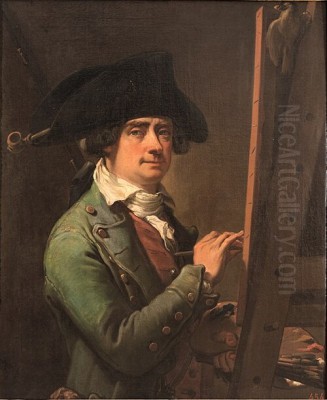
Gaetano Gandolfi stands as a pivotal figure in the landscape of 18th-century Italian art. Born on August 31, 1734, in San Matteo della Decima, a village near Bologna now known as San Giovanni in Persiceto, he navigated the transition from the exuberant dynamism of the Late Baroque to the ordered elegance of early Neoclassicism. His death in Bologna on June 20, 1802, marked the end of a prolific career that significantly shaped the artistic identity of his native city and left a lasting legacy through his paintings, drawings, prints, and even sculptural models.
Gandolfi was not an isolated talent but emerged from a veritable dynasty of artists. His older brother, Ubaldo Gandolfi (1728–1781), was also a highly respected painter, and the two often collaborated and shared influences. Gaetano's son, Mauro Gandolfi (1764–1834), continued the family tradition, achieving success as both a painter and an engraver. This familial context provided a supportive environment and undoubtedly contributed to Gaetano's prominent position within the Bolognese art world.
His life and work offer a fascinating window into the artistic currents of his time, reflecting both the enduring power of local traditions and the impact of broader European trends. From his rigorous academic training to his influential travels and diverse output, Gandolfi forged a distinctive style characterized by technical brilliance, emotional depth, and a remarkable adaptability across different media and artistic movements.
Early Life and Academic Foundations in Bologna
Gaetano Gandolfi's artistic journey began formally at the prestigious Accademia Clementina in Bologna. This institution was a vital center for artistic education, upholding the city's rich artistic heritage, which stretched back to the revolutionary Carracci family – Ludovico, Agostino, and Annibale Carracci – who had revitalized painting in the late 16th century. The academy aimed to instill the principles of solid drawing (disegno) and compositional clarity that were hallmarks of the Bolognese school.
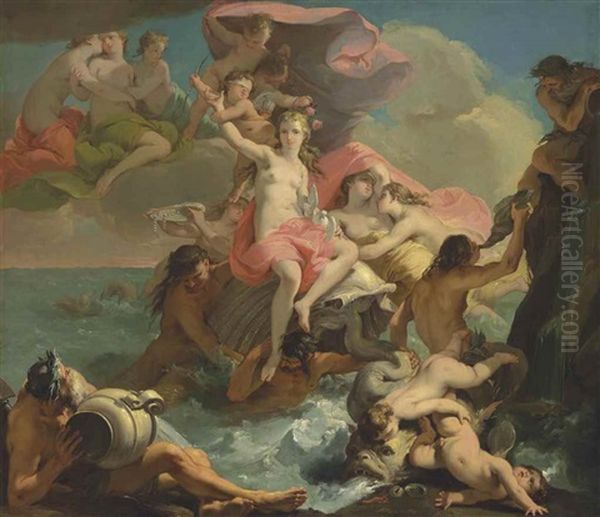
Under the tutelage of respected masters like Felice Torelli (1667–1748) and Ercole Lelli (1702–1766), Gandolfi received a comprehensive education. Torelli represented the established Bolognese tradition, while Lelli, renowned for his anatomical studies and wax models, likely imparted a deep understanding of human form that became evident in Gandolfi's later work. The young artist quickly distinguished himself, winning multiple awards for both painting and sculpture during the 1750s, signaling his precocious talent and versatility.
This period grounded Gandolfi in the fundamentals of Bolognese art, emphasizing strong draftsmanship, balanced composition, and a certain classical restraint, even within the prevailing Baroque idiom. The influence of earlier Bolognese giants like Guido Reni (1575–1642) and Guercino (1591–1666), known for their idealized figures and dramatic narratives, would have been palpable within the academy's teachings and the city's numerous churches and collections.
The Transformative Venetian Sojourn
A significant turning point in Gandolfi's artistic development occurred in 1760 when he undertook a study trip to Venice. The vibrant artistic atmosphere of La Serenissima, then a hub of Rococo elegance and painterly brilliance, exposed him to new possibilities. He spent a year immersing himself in the Venetian school, a tradition celebrated for its emphasis on color (colore) and light.
The most profound influence during this period was undoubtedly Giambattista Tiepolo (1696–1770), the undisputed master of large-scale decorative painting. Tiepolo's luminous palettes, airy compositions, and dazzlingly fluid brushwork left an indelible mark on Gandolfi. Elements of Tiepolo's Rococo sensibility – the lighter colors, dynamic movement, and decorative grace – began to infuse Gandolfi's style, softening the more somber tones and formal structures inherited from his Bolognese training.
Beyond Tiepolo, the broader Venetian environment, potentially including the works of artists like Sebastiano Ricci (1659–1734) or Giovanni Battista Piazzetta (1682–1754), reinforced the importance of painterly effects and atmospheric light. This Venetian experience broadened Gandolfi's artistic vocabulary, equipping him with a more vibrant and expressive style that he would integrate into his subsequent work back in Bologna.
A Leading Figure in Bolognese Art
Returning to Bologna, Gandolfi established himself as one of the city's leading artists. His career flourished, marked by numerous commissions for altarpieces, frescoes, and easel paintings for churches, palaces, and private collectors primarily in Bologna and the surrounding Emilia region. He became a respected member of the Accademia Clementina, eventually serving as a professor, where he influenced a new generation of artists.
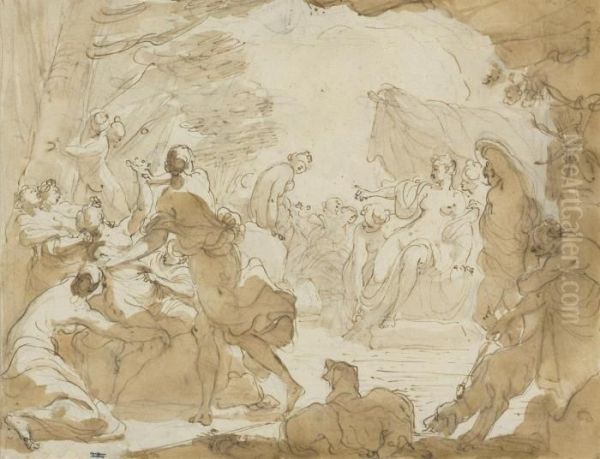
His workshop, often involving collaboration with his brother Ubaldo and later his son Mauro, was highly productive. They tackled large-scale decorative projects, such as the ceiling frescoes depicting the Four Elements in the Palazzo Odorici in Bologna, showcasing Gaetano's skill in complex allegorical compositions designed for architectural settings. Another significant commission was the fresco decoration for the dome of the church of Santa Maria della Vita, demonstrating his mastery of perspective and grand-scale narrative.
Throughout his mature career, Gandolfi skillfully balanced the Bolognese emphasis on drawing and structure with the Venetian sensitivity to color and light acquired during his travels. This synthesis resulted in a style that was both intellectually rigorous and visually appealing, capable of conveying complex theological narratives with emotional resonance and dramatic flair. He remained deeply connected to the artistic life of Bologna, contributing significantly to its churches and public spaces.
Mastery Across Diverse Media
Gaetano Gandolfi's artistic talent was not confined to a single medium. His versatility was a key aspect of his success and influence, demonstrating proficiency in oil painting, fresco, drawing, printmaking, and even terracotta sculpture.
Oil Painting: Religious and Mythological Narratives
Oil painting formed the core of Gandolfi's output. He excelled in religious subjects, creating numerous altarpieces and devotional works. His painting The Holy Family (Sacra Famiglia) exemplifies his ability to infuse sacred themes with tender humanity. The intimate grouping of Mary, Joseph, and the Christ Child, often accompanied by saints or angels, is rendered with soft modeling and warm colors, emphasizing familial love and divine grace.
He was equally adept at mythological themes, often drawing inspiration from classical antiquity. Works like The Birth of Venus showcase his engagement with mythological narratives, interpreted through a lens that blended late Baroque dynamism with emerging Neoclassical sensibilities. His figures, whether divine or mortal, are typically characterized by anatomical accuracy, graceful poses, and expressive gestures, bringing ancient stories to life with contemporary vibrancy. Another example, Diana and Callisto, reveals his skill in depicting complex multi-figure compositions with dramatic lighting and rich textures.
Drawing: The Foundation of His Art
Gandolfi was a prolific and exceptionally gifted draftsman. Thousands of his drawings survive, primarily executed in red or black chalk, often heightened with white. These drawings were not merely preparatory steps for paintings but often stand as autonomous works of art, admired for their fluidity, confidence, and anatomical precision – a skill likely honed under Ercole Lelli.
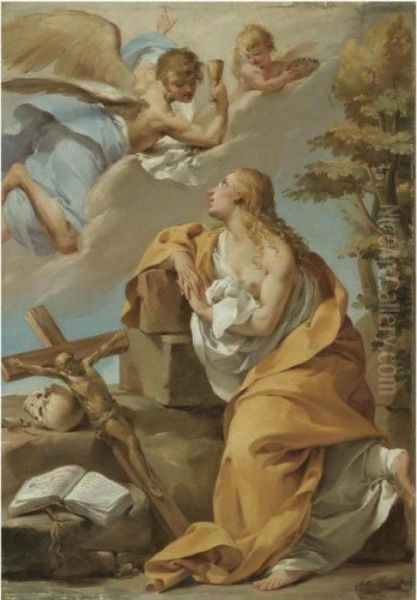
His drawings reveal his working process, capturing initial ideas, exploring compositional arrangements, and studying individual figures or details. They range from rapid sketches capturing movement and emotion to highly finished studies demonstrating his mastery of form and light. The sheer volume and quality of his graphic work underscore the fundamental importance of disegno (drawing and design) in his artistic practice, aligning him with the core tenets of the Bolognese tradition established by the Carracci. Collectors and connoisseurs highly prized his drawings even during his lifetime.
Printmaking: Etching and Innovation
Beyond painting and drawing, Gandolfi was an accomplished printmaker, particularly skilled in etching. He utilized this medium not only to reproduce his own painted compositions, thereby reaching a wider audience, but also to create original works conceived specifically for the print format. His etchings are characterized by lively linework, rich tonal contrasts achieved through dense cross-hatching, and dynamic compositions.
An example like The Adoration of the Shepherds (available in multiple versions, including an etching) showcases his ability to translate the energy and detail of his paintings into the graphic medium. Sources suggest he may have even experimented with and developed new etching techniques, demonstrating an innovative spirit within this field. Printmaking allowed Gandolfi to disseminate his artistic ideas more broadly, contributing to his influence beyond Bologna and securing an additional source of income.
Sculpture: Terracotta Models
While primarily known as a painter, Gandolfi also possessed considerable skill in sculpture, particularly in creating terracotta models, or bozzetti. He won awards for sculpture early in his career at the Accademia Clementina. These small-scale clay models often served as three-dimensional studies for figures or groups in his paintings, allowing him to explore form, pose, and lighting in the round before committing to the final canvas or fresco. Some of these terracottas survive and are appreciated for their immediacy and expressive handling of the material, offering further insight into his creative process.
The London Journey and the Embrace of Neoclassicism
In 1788, relatively late in his career, Gandolfi embarked on another significant journey, this time to London. While the exact impact of this visit is debated by scholars, it exposed him to a different artistic milieu, particularly the flourishing English school of portraiture. Artists like Sir Joshua Reynolds (1723–1792) and Thomas Gainsborough (1727–1788) were at the height of their fame, developing styles characterized by psychological insight and sophisticated handling of paint.
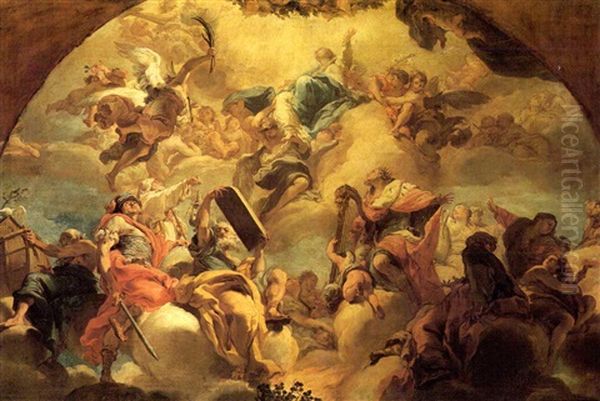
Exposure to these trends, combined with the broader Neoclassical movement sweeping across Europe, seems to have influenced Gandolfi's later work. While he never fully abandoned his Baroque and Venetian roots, his style in the final decades of his life often shows a greater emphasis on clarity of line, more restrained compositions, and a certain classical elegance in the depiction of figures. This shift reflects an adaptation to the changing tastes of the era, which increasingly favored the order, rationality, and moral seriousness associated with Neoclassicism, championed by artists like Anton Raphael Mengs (1728–1779) in Rome and Jacques-Louis David (1748–1825) in Paris. Pompeo Batoni (1708–1787), active in Rome, represented a similar bridge between late Baroque grace and Neoclassical structure.
Gandolfi’s late style, therefore, represents a unique blend: the painterly richness derived from Venice, the solid draftsmanship of Bologna, and the refined linearity and idealized forms of Neoclassicism. He navigated this transition adeptly, maintaining his artistic identity while responding to contemporary developments.
The Gandolfi Workshop: Family and Collaboration
The Gandolfi name was synonymous with art in Bologna for several decades, largely due to the collaborative nature of their practice. Gaetano frequently worked alongside his older brother, Ubaldo. While each had his own distinct artistic personality – Ubaldo is often seen as perhaps more vigorous or rustic, Gaetano more refined – they shared commissions and likely influenced each other significantly throughout their overlapping careers until Ubaldo's death in 1781.
The next generation continued the tradition, with Gaetano's son, Mauro, becoming an integral part of the workshop. Mauro developed his own reputation, particularly as an engraver, but also assisted his father on painting projects. This family enterprise model was common in the period, allowing for efficient production, training of younger artists, and the consolidation of artistic reputation and patronage.
Beyond the family, Gaetano also collaborated with other specialists when required. Records indicate collaborations with decorative painters or sculptors like Serafino Viani on specific projects, highlighting the interconnected nature of artistic production for large-scale commissions in churches and palaces. The Gandolfi workshop was thus a dynamic hub of artistic activity, central to the Bolognese art scene.
Legacy and Enduring Influence
Gaetano Gandolfi died in Bologna in 1802, leaving behind a substantial body of work and a significant artistic legacy. He is remembered as one of the last great exponents of the Bolognese school, skillfully integrating its traditions with external influences, particularly from Venice. His ability to navigate the stylistic shift from Late Baroque/Rococo to Neoclassicism demonstrates his adaptability and deep understanding of artistic principles.
His influence extended through his numerous students at the Accademia Clementina and through the dissemination of his works via prints. He maintained a high level of technical proficiency across multiple media, particularly excelling in painting and drawing. His drawings, in particular, continue to be highly sought after by collectors and museums worldwide, admired for their elegance, vitality, and technical mastery.
While perhaps overshadowed in international fame by his Venetian contemporary Tiepolo, or by the leading figures of the burgeoning Neoclassical movement like David, Gandolfi remains a crucial figure for understanding Italian art in the latter half of the 18th century. He represents the vibrancy of regional artistic centers like Bologna and the complex interplay of tradition and innovation during a period of significant stylistic change. His work continues to be studied and appreciated for its synthesis of painterly beauty, compositional skill, and emotional depth.
Conclusion: A Versatile Master of Transition
Gaetano Gandolfi's life spanned a period of profound transformation in European art. From the lingering splendors of the Baroque to the disciplined ideals of Neoclassicism, he absorbed, adapted, and contributed, forging a unique and enduring artistic identity. Rooted in the rich soil of Bolognese tradition, nourished by the light of Venice, and responsive to the intellectual currents of his time, he produced a body of work remarkable for its quality, diversity, and emotional resonance. As a painter, draftsman, printmaker, and teacher, Gaetano Gandolfi remains a testament to the enduring vitality of Italian art in the 18th century, a versatile master whose works continue to captivate and inspire.